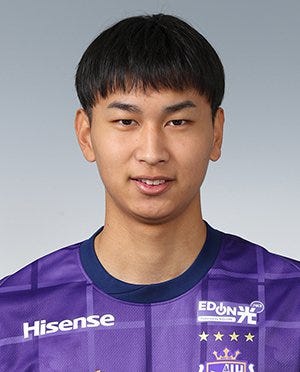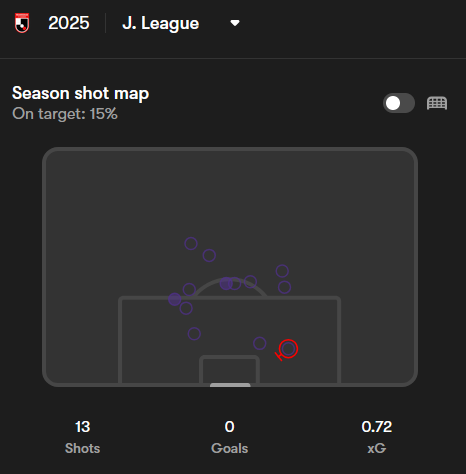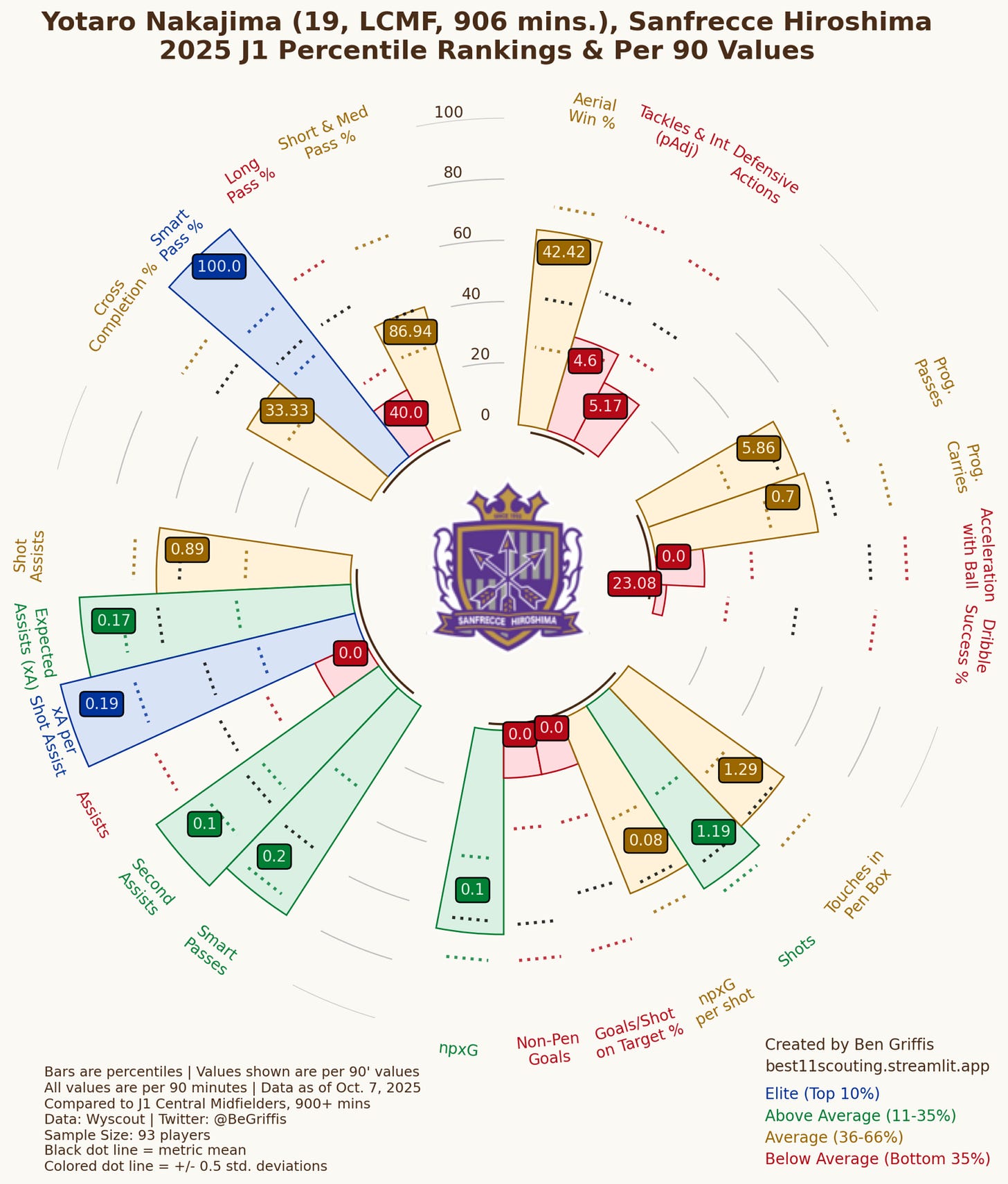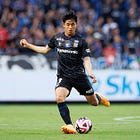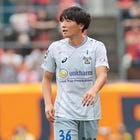Shogun Soccer Scouting #16: Yotaro Nakajima
Deep-Lying Tempo Controller with Excellent Vision & Passing Range
Happy Halloween, well soon enough anyway! This report should neither be spooky nor a surprise to most people who watch Japanese football as today I’ll be talking about Yotaro Nakajima! On the other hand, if you’re interested Kawasaki Frontale do a Halloween-themed starting XI graphic every year and those are always spooky & fun!
Another slight segue, I recently went on the J-Talk Podcast to talk about Japan’s historic win over Brazil: the concerns & positives, as well as how the Japan squad could be shaping up for the World Cup next year!
Anyway, let’s get started!
tl;dr (too long; didn’t read):
Subtle, timed movements & great spatial awareness. Passing technique across all ranges. Limited physical & defensive profile currently caps his ceiling for the highest levels.
Date of Birth: April 22nd, 2006
Age: 19 years old
Nationality: Japan
Position: Central Midfielder (Deep lying play-maker) or Attacking Midfielder in a 3-4-2-1 (club), 4-2-3-1 (youth national team), etc.
Club: Sanfrecce Hiroshima (J1)
Squad Number: #35 (2025 season)
Height/Weight: 1.75m // 68 kg (Source: Soccer Digest)
VIDEO NOTE: Sanfrecce Hiroshima’s HOME kits are purple patterned shirts, navy shorts, with white lettering, purple socks. AWAY kits are white shirt, socks, and shorts with black lettering & purple highlights. I’m using footage from the 2025 J.League J1 season & various cup competitions. Nakajima wears #35.
DATA NOTE: The percentile ranking stats are all from WyScout.
Space, Positioning, & Runs
The ability that Nakajima has that empowers all of his other great traits is his ability to understand space. On top of the usual scanning and reading of sequences that unfold during games, it is also the speed of his processing and awareness that truly elevates him over other midfielders especially when playing in the double-pivot. Despite his young age he’s very vocal and points out potential passes or warnings to his teammates.
In the build-up phase, Nakajima will either drop deep or keep his position between-the-lines to offer an option depending on the opponent. Hiroshima do have players in the Back 3 who can pass so the midfielders usually don’t drop all the way into the back-line.
Due to his reading of the game, he is usually able to sniff out the right positions ahead of time. This can be seen in attacking transitions where Nakajima displays an clairvoyant readiness on turnovers and can ignite a counterattack by receiving in a good spot and releasing a quick pass.
One of his virtues is that he waits patiently if he’s already in the right spot and doesn’t move unnecessarily. Across the positions that Nakajima has played (in the double pivot and further forward), he rotates well with teammates and creates openings for himself and others. When playing in attack behind the striker, Nakajima is quite adept at dropping off the defensive line to receive between-the-lines. While he can make the occasional run behind centrally or out wide, he also cleverly fakes that run to check back to receive as well.
Ball Control & Dribbling
Nakajima has a great first touch that he easily converts into other aspects of his play. Nakajima is not a player that stands upright to an opponent to dribble 1v1 but his close control and agility to turn away from opponents allow him the ability to maneuver in tight areas. His main moves are shifting his weight and fake/distract with his body shape and gaze before pushing away in a different direction. For Nakajima it’s less about completely blowing past a player but creating that little separation to make a pass through an opening.
Nakajima is not much of a ball carrier over medium-long distances, preferring to distribute and his close control allows him to combine quickly in free-flowing pass-and-move sequences across the pitch. While Nakajima is good at finding pockets of space, how well he can handle more immediate pressure is something to keep an eye on as he can get bumped off the ball from harder physical contact.
Passing
Finding and moving into space is all well and good but on top of that, Nakajima is able to successfully execute on actions once he receives in these positions. Nakajima excels in moving the ball across the different zones of the pitch. He has a variety of passes in his toolkit from lay-offs, flick-ons and has the vision to find players across all ranges. Nakajima’s passes are predominantly right footed and uses outside of right foot in some circumstances where he would use his left to throw opponents off.
What is most noticeable about Nakajima’s passing, especially when playing in the double pivot is how despite his age he can control the team’s tempo. He can initiate quick sequences through his 1-touch passing to immediately take advantage of holes in the opponent shape…
… and in other situations, Nakajima doesn’t rush unnecessarily, slowing down and exchanging a few passes with teammates close by to provide time for the team to re-organize into shape.
Aside from ball-progression across the 3rds of the pitch, when Nakajima is played further forward behind the striker he does get involved in chance creation. Directly in terms of through-balls into the final 3rd and/or box but also releasing it to others to make the cross or cut-back instead. The lack of league assists are a rather unfortunate by-product of Sanfrecce’s notorious profligacy over the past few seasons. In any case, he is quite involved as the second or third pass before the shot assist rather than being the direct creator.
Shooting, Crossing, & Set-Pieces
Nakajima’s role as a creator and his deeper positioning to orchestrate the attack does mean that by nature his shot locations are mostly restricted to outside the box. Overall, he’s had a paltry 13 shots in the league with only 2 on target, all adding up to 0.72 xG. Given the very small sample size (and I’m including footage from non-J1 play in the video below), there really is not much else to discuss here. His goals (and assists for that matter) have all come in cup competitions against inferior opposition rather than in league play.
As an added bonus, Nakajima occasionally takes free kicks and corner kicks as the team’s Right footed taker from either side as he does possess a decent whipped delivery on the in-swing or out-swing. If not, he’s hanging around the outside of the box as rest-defense as he’s not much of a threat in the box himself. When drifting out to the wing in open-play he can cross the ball to at reasonable accuracy but it’s not really a strength. Ideally a team will have him setting up the guys who are good-to-excellent at crossing instead.
Defending & Physical Attributes
In regard to his physical metrics, Nakajima is not the most mobile nor does he make a lot of sprints per game. He can still make reasonable contributions in defensive transitions but a lack of top-end speed & explosiveness can hurt him especially if you extend his outlook to a higher level of play.
Top speed (J.League official stats): 32.1 km/h in 2024
32.5 km/h in 2025
The big caveat here is that being a mobile high intensity player is neither his role in the team nor does it match his playing style, even if it does bear mentioning. As I’ve discussed in earlier sections about his fantastic movement & spatial recognition, Nakajima is about subtle, timed movements rather than frenetic chaos energy. This does inform potential suitors that Nakajima needs to be paired with a tough, mobile partner, which is why he has been at his best when paired up with the energetic & combative Satoshi Tanaka compared to other Sanfrecce midfielders this season.
One of a variety of aspects he has improved upon since his debut last year has been his actions while in a block. He is able to competently shift across in tandem with his teammates and also block potential passing lanes. However, Nakajima still does get caught unawares when defending in the box or from lofted balls behind. If he is to indeed play deeper on a regular basis this is definitely an aspect he needs to improve, otherwise he’ll continue to be pushed into positions further forward instead.
As Nakajima has grown accustomed to the rigors of professional football, his aggressiveness in tackling and ground duels has improved to a sufficient level in the context of J1. As Sanfrecce Hiroshima are a team that heavily emphasizes physicality and intensity in defensive play, this is a good sign for his future but he will still need to strengthen considerably for European football leagues. Many future opponents at higher levels will be more tight and physical with him to try and disrupt his rhythm than what I’ve seen in the J.League so far. Given his stature he is not particularly adept in the air, either mistiming his jumps or not getting involved much at all.
Sanfrecce Hiroshima are a very high pressing/counter-pressing team. Whether from the double pivot or in the line behind the striker, Nakajima is tasked with applying pressure. He performs his task diligently and uses his intelligence and awareness to understand when he should go or stay. As one might imagine his real contributions start immediately after his team has won the ball in these phases of play.
Overall, there are some aspects of Nakajima’s physical and defensive abilities that are a concern and need to be weighted against his considerable on-the-ball contributions. Careful thought needs to be placed in terms of how to deploy him & how to cover up for his current weaknesses in these aspects.
There have been some injuries that have limited his league minutes, notably a knee injury that lasted for a couple of months earlier this year. A concussion prevented him from joining the U-20 World Cup squad but that was more of a freak accident so I think the thing to keep a close eye on is the knee injury. Nakajima has been rotated a lot, both as a starter or off the bench, as Sanfrecce Hiroshima have been involved in many domestic and continental competitions over the past two seasons.
2024 Season: 302 league minutes (483 across all competitions)
2025 Season: 801 league minutes (close to 2000 across all competitions)
Summary
Yotaro Nakajima is a technical, deep-lying ball progressor that can ideally set the tempo on the team with wonderful technique, smart positioning, and passing across all ranges. I think over the past year since his professional debut in 2024, his physical intensity in terms of aggression in duels has been up to a good standard at the J1 level (and in particular, at the demanding level Sanfrecce Hiroshima play at under Michael Skibbe) but the levels of mobility/sprinting/acceleration are still issues that pop up in my head when I try scaling him up to a top 5 European standard.
Some of his strengths highlighted throughout this report perhaps don’t translate into the data like in the below visualization due to his limited playing time and the fact that it’s been split between a more attacking position rather than just in the double pivot. His role is one that should be judged on his contributions from the second/third/etc. passes before a shot rather than in terms of direct goals/assists.
Yotaro Nakajima has been with Sanfrecce Hiroshima his entire life since the 3rd grade when he joined the Junior team. From there he continuously moved up the ranks through the Junior Youth and Youth teams to become the youngest ever player to sign a professional contract for Sanfrecce Hiroshima in 2023 at 17 years old. In addition, he has been a regular for various age-groups in the youth national team. In terms of major tournaments, he has been a part of the team that won the U-17 Asian CUp in 2023, participated in the 2023 U-17 World Cup, and most recently in the U-20 Asian Cup this year.
Overall, I rate his potential highly. His combination of technical and spatial attributes should make him very attractive to possession-heavy teams. Even still, I will warn that Nakajima will need time to acclimatize to a European standard and therefore I don’t think he should be jumping too highly immediately from the J.League. FC Köln (a partner club of Sanfrecce Hiroshima) had already registered their interest in the past and a club around that level is probably the ceiling in terms of potential destinations at this moment. I think bigger clubs (Europa/Champions League level) will want to monitor how he does at the Bundesliga or even top-end of the 2.Bundesliga first before ramping up their interest further.
The knee injury sustained earlier this year will also need monitoring considering the increased demands in terms of physical contact and endurance that Nakajima will have to face in Europe. Of course, these are things that can be worked on at the training ground, much like Ao Tanaka’s physical development over the years since he arrived in Europe, it will be up to the physical/medical staff at his club to plan his development in these aspects. As mentioned before, any team that snaps him up will also need to think about how to deploy him in their midfield, weighing all of these factors into mind. If they’re not convinced by his defensive capabilities in the double pivot, they may want to continue giving him minutes further forward instead until he is ready for a deeper role.
Yotaro Nakajima is a very skilled player that various teams have been monitoring for a while, I imagine a move to Europe will come soon within the next year.
Thanks for reading!
Resources, Limitations, etc.
Video analysis: DaVinci Resolve 18
Tactical diagrams: Tacticalista
Time period: 2024 J1 Season & 2025 J1 Season, Asian Champions League 2025/2026
Footage: Broadcast footage, no tactical camera
Stats: FBref, Transfermarkt, WyScout, FotMob
Player radars: Ben Griffis


